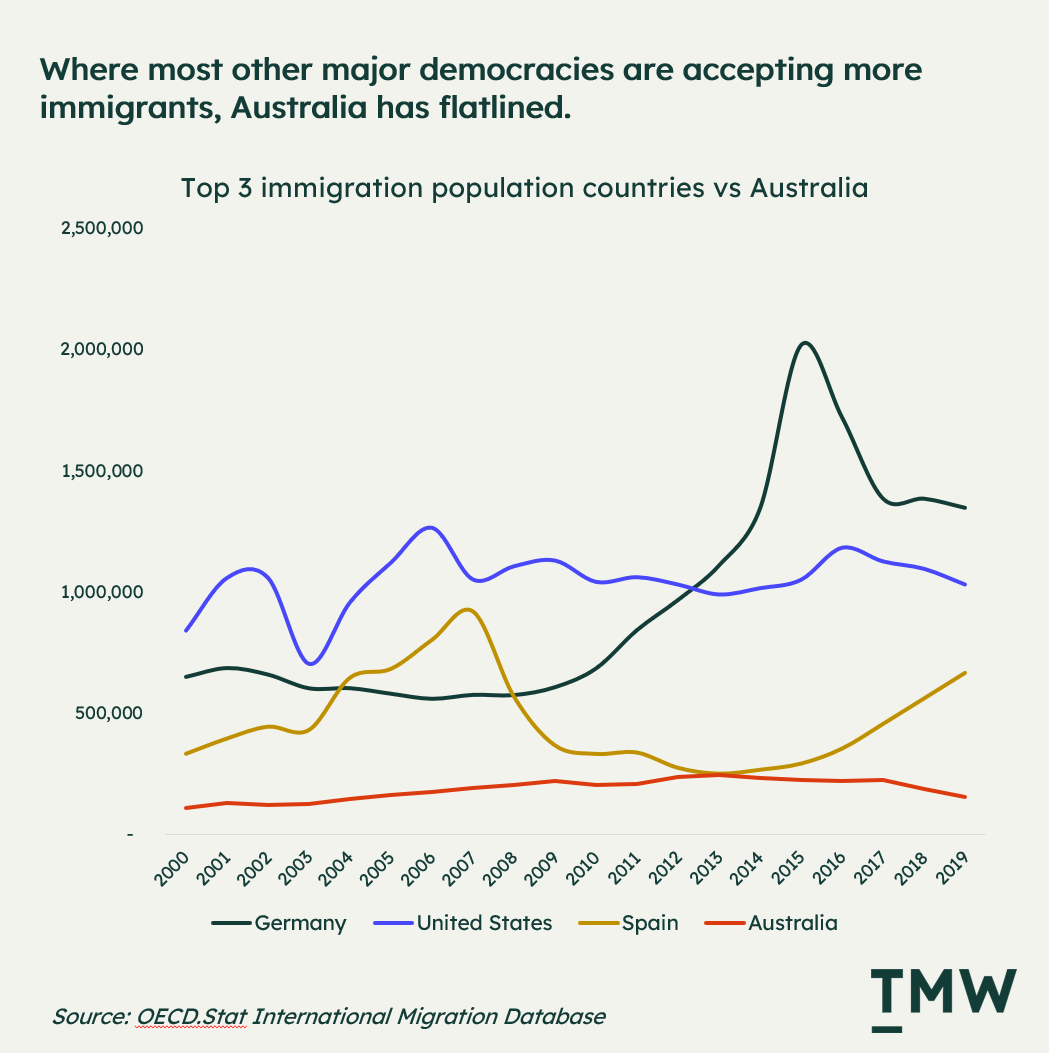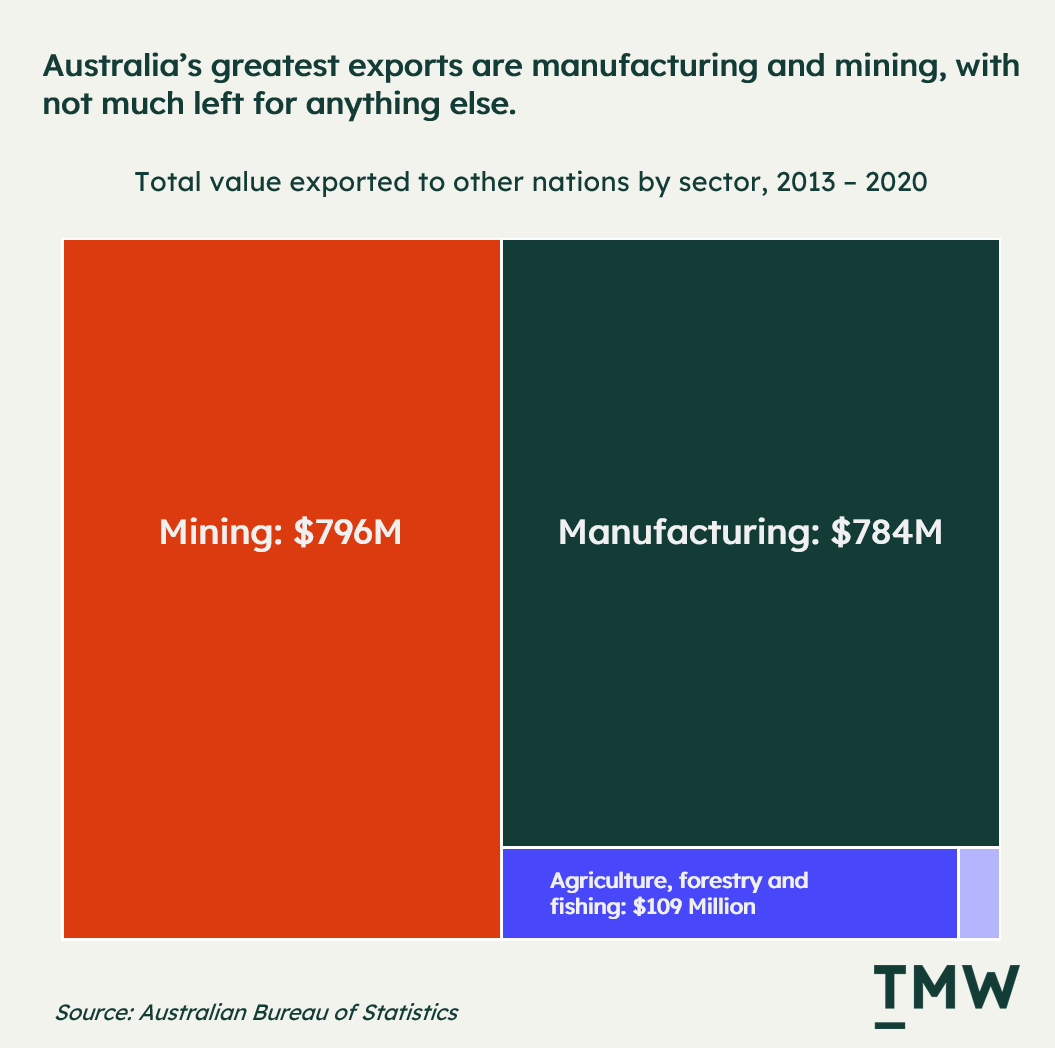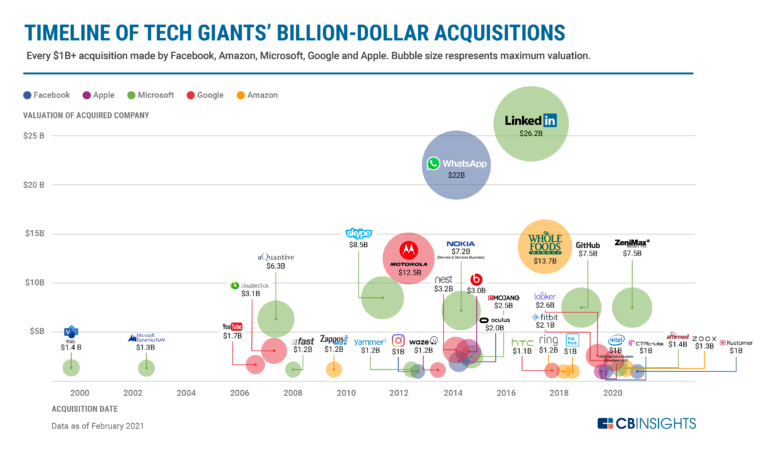TMW #091 | The left-out nation
Welcome to The Martech Weekly, where every week I review some of the most interesting ideas, research, and latest news. I look to where the industry is going and what you should be paying attention to.
👋 Get TMW every Sunday
TMW is the fastest and easiest way to stay ahead of the Martech industry. Sign up to get the full version delivered every Sunday for this and every TMW, along with an invite to the TMW community. Learn more here.
Here’s the week in Martech:
- The left-out nation: Why doesn’t Australia have a thriving tech industry?
- Tracking acquisitions: LinkedIn is the most expensive so far
- Apple is expanding its ads business: With a DSP and more display options
- Everything else: Adtech fines, the Bureau of Privacy, policy at TikTok, AI in creative industries, Martech ROI, and a good Lion King TikTok.
✍ Commentary
The left-out nation
Australia isn’t a place you go to build a career in marketing or tech. And there’s a reason for why. This week The Tech Council of Australia published its "roadmap to one million tech jobs", so this is a good opportunity as ever to analyze the state of the technology community and where it might be headed.
I normally don't focus on a single country in TMW, but come with me as I talk about the nation I call home and all the baffling reasons why Australia should have a vibrant technology and marketing industry but doesn’t.
Australia is a nation of 26 million people, a size just over half the population of California, and it's home to a number of important global technology companies like Atlassian (Jira, Confluence), Canva, Culture Amp, and Envato. The nation is also one of the few places in the world that offers free, universal healthcare, a college tuition scheme that works as a loan that you can practically ignore, and relatively low taxation rates.
Australia also builds great cities. My hometown of Melbourne has been voted the most livable place in the world for seven years. Add in modern infrastructure, the growing ranks of tech investors, world-class education, and for the most part, diverse communities of cultural expression, and you have one of the most desirable places to live in the world. Don’t get me started on the beaches.
But despite this, the technology and marketing scene has never really gone anywhere. We can’t hire enough workers to build great companies, the vacancy rate of technology jobs is 60% higher than any other industry, and only 1 in 16 Australians working in some form of a technology career.
The Tech Council of Australia is now saying that we need at least 650 thousand people to join the tech workforce in Australia with the majority of that coming from reskilled workers. Of all the benefits of living in Australia, there really isn’t any reason why this country couldn't be a major technology center in the world. But the outlook isn’t looking good.
If you’re living and working in the Martech industry here in Australia, the community is small and it definitely feels like a village. One of my former customers once said it’s a little “incestuous - like everyone knows everyone here because the industry is so small.”
With so few people working in this space, one of the questions I often ask myself is if the outlook of Australia is one worth investing in when it comes to marketing technology. I’m going to draw three broad concepts for why the future is not looking bright for the great down under, a few ways we could fix it, and what Australia's tech contribution means for the global economy.
An island fortress
One of the things Australia is famous for is its strong border policies. We are a nation that is surrounded by millions of kilometers of water. The country is also geographically removed from the rest of the world - It takes about 7 hours to fly from New York to London, but for a flight out of Sydney (Australia’s capital) it takes more than 20 hours to get to either of those destinations.
For these reasons, it’s challenging to attract international migrants to come here and build careers in technology. Australia is like one big island fortress, surrounded by a massive moat – it’s hard to break in, and even harder to break out.
But when it comes to immigration, the US leads the world, with more than 50 million residents settled there from other countries. In contrast, Australia is behind Japan, Korea, and Canada in migration over the past 20 years and since 2014 the year-on-year rate of people accepted as immigrants into the country has been rapidly declining from -4% in 2015 to -17% in 2019.

This is not a supply-side problem, it’s a demand one. Up until very recently, the immigration policy under the Liberal government has been to slow our immigration down to “protect our quality of life.” But in reality, the opposite is happening.
Australians don’t take in enough people annually to build an economy where technology and marketing thrive. This means we have fewer commutes in our cities (great) but fewer opportunities for career advancement and for entrepreneurs to build companies (not so great).
With only 6% of people working in tech currently, we have a huge downfall of people who are let into the country annually. A rough estimate of 20 years of Australian immigration means that less than 300,000 skilled migrants have settled in Australia to work in the tech industry since the year 2000 with a forecast of 119 thousand over the next decade. Australians are often very risk averse when it comes to public policy but letting the country continue as a minority population can’t be good either.
If you compare Australia with the United States, there’s also a large cultural difference and the handling of international migrants. The US is a nation that was settled by the British Empire, and built a society from scratch, like Australia. But the United States bills itself as a nation for the immigrant, the land of opportunity and where millions have flocked over the past 200 years to work hard and earn a living.
Many of the United State’s largest tech company CEOs originate from outside of the country. Almost 45% of Fortune 500 companies have been founded by immigrants or their children. In contrast, Australia does not have this kind of strong migrant culture where you come to live here to work hard and find opportunities. The boards of ASX 100 listed companies according to the Australian human rights board are “overwhelmingly Anglo-Celtic men, who are drawn from male-dominated business networks.”
The opportunities in marketing or tech come from an ability to create a big brand or to build solutions that can reach large-scale adoption. And big brands need big populations. Until Australia fixes its immigration policies and does even just a little bit of marketing to motivate people to invest their technology careers into the country, little will change.
A mining economy
Australia is a nation known for its massive deserts. The country is mostly just an arid, mad max style wasteland with a few coastal villages like Melbourne, Sydney and Brisbane. Because of this, the mining sector is integral to the Australian economy. It makes up more than 11% of the economy’s GDP and it’s the thing Australia exports the most.

This is one of the main reasons why Australia lacks a meaningful technology industry. We don’t have the right kinds of incentives at a government or private industry level to really fund technological innovation like many other nations.
Like Saudi Arabia’s oil wealth we are fine living off the resources we create from exporting iron ore, aluminum, and lithium. When a nation doesn’t invest in tech, you have exactly what we have today – a cottage industry with a few global exports and a group of VCs you can count on two hands.
If you look at another country like China you can see a big difference in how the nation is planning for the future. China is increasingly investing in technological innovation and has leveraged the global economy to build massive internet companies like Alibaba, Bytedance, and Tencent. The country is planning to have more than 10% of GDP come from digital goods.
China has been building technology companies and is rapidly scaling investments into its digital economy because it's becoming very clear that for a nation to compete on the world stage, digital innovation is a priority. Australia's investment in the tech sector is growing, but like most other breakout markets, we’ve probably missed the boat.
The hand-me-down nation
What I mean by the boat is the race to build dominance in the internet economy. Australia is a country where we appropriate technologies and ideas from elsewhere. We stream movies on Netflix, buy products through Amazon prime, listen to music on Spotify, and manage our staff on Quickbooks. And we and do it all on a smartphone manufactured by Apple or Samsung.
Outside of a very small group of influential technology companies, Australia brings little to the global internet economy. But our contribution is significant.
Canva, is one of the most interesting examples of a company to break out of Australia and truly go global with a peak valuation of $40 billion. However, I was recently visiting San Francisco, and outside of Notion billboards, I only saw Canva ads on the way into the city, during my stay, and on the way out. There’s a reason why Canva is running so many ads there and not Sydney – their user base of startup founders, and marketers tend to live in Silicon Valley, it's where the people are.
The problem with the startup technology space in Australia is that the ceiling is too low. We have to do more with less because the nation has allowed incumbents like Amazon, Apple, and Salesforce to completely saturate existing markets while sucking up talent into regional offices and making it harder for our own kinds of companies to compete. Like Japan, South Korea, or most of the smaller European nations, for Australians to build something great they need to tap into the US market, and to do that is no small task.
If we look at how the workforce is organized, overseas influence is significant. One in ten Australian jobs rely on foreign investment and foreign-owned companies bring in 11% of the nation's tax revenue. Companies like Amazon are doubling their growth in Australia every year and they are just getting started.
Australia is unlike larger population centers where achieving scale in marketing means building for the residents of your own country. This introduces friction for any company that wants to reach more than 26 million people in a single country. The net positive here is that Australians are default building technology solutions on hard mode, which means more tested and tried entrepreneurs who might flourish in markets where more customers are easier to access.
Does Australia want a future in tech?
As all major economies continue to become more sophisticated with technology, I still believe that despite these three reasons that Australia could be a major player in the global technology and marketing industry. There’s plenty to do, and most of it won’t be realized until the next generation.
Right now, Australia feels like a left-out nation when it comes to innovation in digital technology. But if the great down under can fix how it’s positioned around the world, let more people with a willingness to enter the tech industry into the country, and incentivize private and public industry to invest in skills, startup capital, and tech-positive policy, then we may have a shot at building a thriving technology community in one of the most livable places in the world.
📈Chart Of The Week
Tracking acquisitions. One of the biggest surprises here is how much Microsoft paid for LinkedIn, and in the five years since, has done very little with it. Link

📰 Latest Developments
Apple expands its ad business. Apple made a series of announcements stating that the company is now actively working on a Demand Side Platform to expand ad bidding capabilities and will start publishing ads in the App Store today tab (it previously only ran search ads). Most of the criticism of this is that Apple’s privacy messaging is hypocritical because the company is actively building tools to track and target its own users. But it’s far more likely to be the consequence of an enterprise company where the Ads product managers are not talking enough to the brand team who are putting all those “Privacy, That’s iPhone” billboard ads up. DSP. TODAY TAB. ANALYSIS.
Criteo fined $65M. France has caught the Adtech company breaching GDPR consent rules. The accusation is that Criteo built a “manipulation machine” that confuses consent and expands progressive user profiling. The contention is that Criteo does not have a legal basis for the technology. It’s probably not the best time to be building Adtech in Europe right now. Link
The BOP. US Congress is exploring the idea of setting up a national Bureau of Privacy (BOP) that would be part of the Federal Trade Commission. This would be one of the first times where, if the bill succeeds, it sets up a specific government body to enforce privacy law violations. We are moving towards a private web. Link
📚 Reading
Policy at TikTok. A deep dive into the world’s biggest apps and a growing concern for national security and privacy. A good read in the context of my analysis of TikTok a few weeks ago. Link
The newsletter boom is over. How Covid-19 changed the newsletter industry, how it’s changing back and what will remain. (don’t worry, I’m not going anywhere). Link
The Journalistic coverage of Web3. David Rosenthal’s blog on how media outlets covered Web3 startups over the bull market of late 2021. One example is an NYT piece that profiled Helium, a company presented as a Web3 startup with actual utility outside of financial speculation. The NYT piece neglected the company’s operating metrics and didn’t validate the claims the company made about who works with them. Instead, it took a blogger and a few Twitter users to expose the company's lack of revenue growth, Ponzi-like dynamics, and lying about the companies that work with them. Part of the Web3 collapse is mediated by the role of media companies and how they promoted these startups. Link
🔢 Data & Insights
Data accessibility. 89% of marketers cite their biggest problem with analytics is a lack of access to data sources. Link
Why do we use spreadsheets? A report as part of the Martech 2022 Career and Salary Survey suggests that most marketers have a critical reliance on spreadsheets. Microsoft Excel is one of the most important and enduring apps in business and no one can seemingly disrupt it. Link
The eclipse is happening. TikTok is forecasted to take over Meta in influencer marketing spending this year. Link
💡 Ideas
Graph database technology. A replacement for third-party cookies? Link
AI in the creative industries. Two interesting pieces unpack how copywriting, animation, and illustration apps using artificial intelligence can impact entire industries. Despite Google’s insistence that content won’t be included in search results if generated artificially, SEO manipulation using AI is a growing opportunity. I do think there are limitations with these technologies as their parameters are based on past engagement and creative output. It’s hard for an AI to make something truly novel by itself. SEO. ANIMATION.
Calculating Martech ROI. There are many aspects that influence an analysis of if a company was actually better off when it purchased marketing software. Link
✨ Weird and Wonderful
Mastercard and Visa suspend Pornhub. This has been a long time coming, but the credit card issuers have now moved to suspend purchases on the website until the company can prove that they are not trafficking child pornography. Link
Meta’s new chatbot has thoughts. Ask it about what it thinks about Mark Zuckerberg. Link
Lion King, but make it a product launch. A very relatable TikTok. Link
Stay Curious,
Make sense of marketing technology.
Sign up now to get TMW delivered to your inbox every Sunday evening plus an invite to the slack community.
Want to share something interesting or be featured in The Martech Weekly? Drop me a line at juan@themartechweekly.com.
